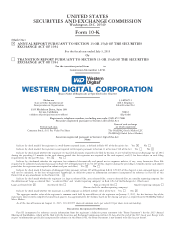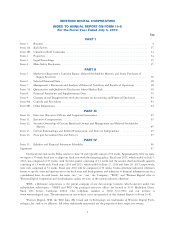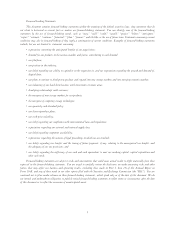Western Digital 2015 Annual Report Download - page 17
Download and view the complete annual report
Please find page 17 of the 2015 Western Digital annual report below. You can navigate through the pages in the report by either clicking on the pages listed below, or by using the keyword search tool below to find specific information within the annual report.Manufacturing
We believe that we have significant know-how, unique product manufacturing processes, test and tooling,
execution skills and human resources to continue to be successful and to grow, as necessary, our manufacturing oper-
ations. We strive to maintain manufacturing flexibility, high manufacturing yields, reliable products, and high-
quality components. The critical elements of our HDD production are high volume and utilization, low cost assembly
and testing, strict adherence to quality metrics and maintaining close relationships with our strategic component
suppliers to access best-in-class technology and manufacturing capacity.
HDD manufacturing is a complex process involving the production and assembly of precision components with
narrow tolerances and thorough testing. The assembly process occurs in a “clean room” environment that demands skill
in process engineering and efficient space utilization to control the operating costs of this manufacturing environment.
Our clean room manufacturing process consists of modular production units, each of which contains a number of work
cells. We continually evaluate our manufacturing processes in an effort to increase productivity, sustain and improve
quality and decrease manufacturing costs. We continually evaluate which steps in the manufacturing process would
benefit from automation and how automated manufacturing processes can improve productivity and reduce manufactur-
ing costs. For our non-HDD products, we leverage the efficiencies of contract manufacturers when strategically advanta-
geous. For a discussion of associated risks, see Part I, Item 1A of this Annual Report on Form 10-K.
Materials and Supplies
The main components of the hard drive are a head-disk-assembly (“HDA”) and a PCBA.
The HDA includes heads, magnetic media, head positioning mechanism (“actuator”) and spindle motor. A rigid
base and top cover contain these components in a contamination-controlled environment. One or more disks posi-
tioned around a motor-driven spindle hub that rotates the disks comprise the disk-pack assembly. The disk is made
up of a smooth substrate on which thin layers of magnetic materials are deposited. The head stack assembly (“HSA”) is
comprised of a magnetic positioner and a pivot-arm module on which the head gimbal assemblies (“HGAs”), includ-
ing suspension, are mounted. Each disk surface has a head suspended directly above it, which can read data from or
write data to the spinning disk. Other key components of our hard drives are pre-amps and voice coil magnets.
The PCBA includes both standard and custom integrated circuits, an interface connector to the host computer
and a power connector. The integrated circuits on the printed circuit board typically include a power device that con-
trols the motor and HSA positioner, and a system-on-chip (“SoC”) comprised of a drive interface, controller and
recording channel. The drive interface receives instructions from the host computer, while the controller directs the
flow of data to or from the disks and controls the heads. The location of data on each disk is logically maintained in
concentric tracks divided into sectors. The host computer sends instructions to the controller to read data from or
write data to the disks, based on logical track and sector locations. Guided by instructions from the controller, the
HSA pivots in an arc across the disk until it reaches the selected track of a disk, where the data is recorded or
retrieved.
We design and manufacture a substantial portion of the heads and magnetic media required for our products.
Consequently, we are more dependent upon our own development and execution efforts and less able to take advan-
tage of head and magnetic media technologies developed by other manufacturers. We depend on an external supply
base for all remaining components and materials for use in our HDD product design and manufacturing.
The key components used in the manufacture of our SSDs are the NAND semiconductor media and SoC which
are acquired from third party suppliers. The NAND flash products used in our SSDs are sourced from multiple tier-
one NAND manufacturers. We have established deep relationships with these vendors to assure continuous supply of
NAND, as well as sufficient technical depth of technology access to enable continuous cost and technology leadership
of our SSD product portfolio offering. Additionally, we are exploring strategic options to further strengthen and
deepen our collaboration with select NAND partners to support the future growth of our SSD business. Additionally,
the key component in our media players, the controller, is acquired from third party suppliers.
We believe that our sourcing strategy currently enables us to have the business flexibility needed to select high
quality, low cost suppliers as product designs and technologies evolve. We generally retain multiple suppliers for each
11
























